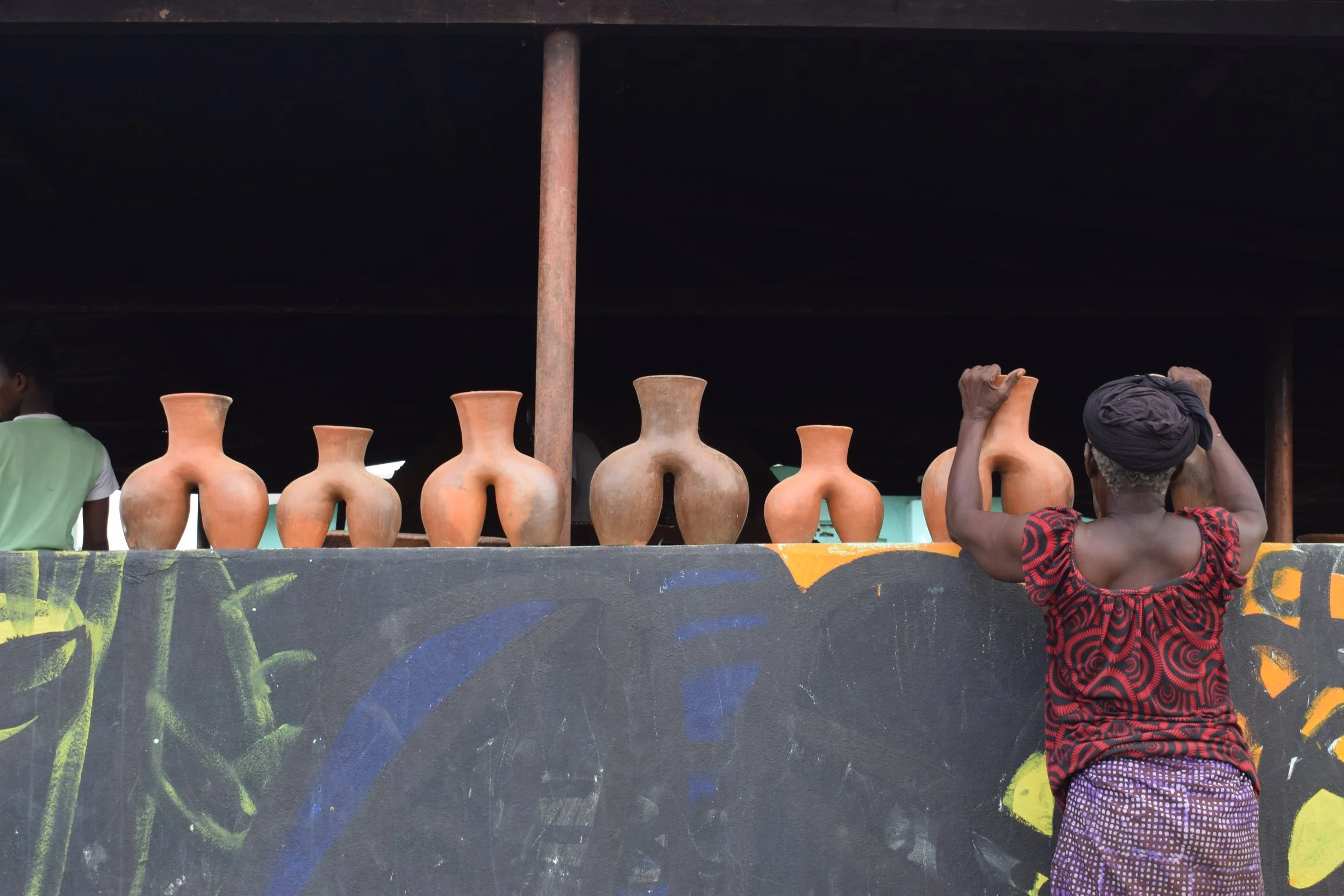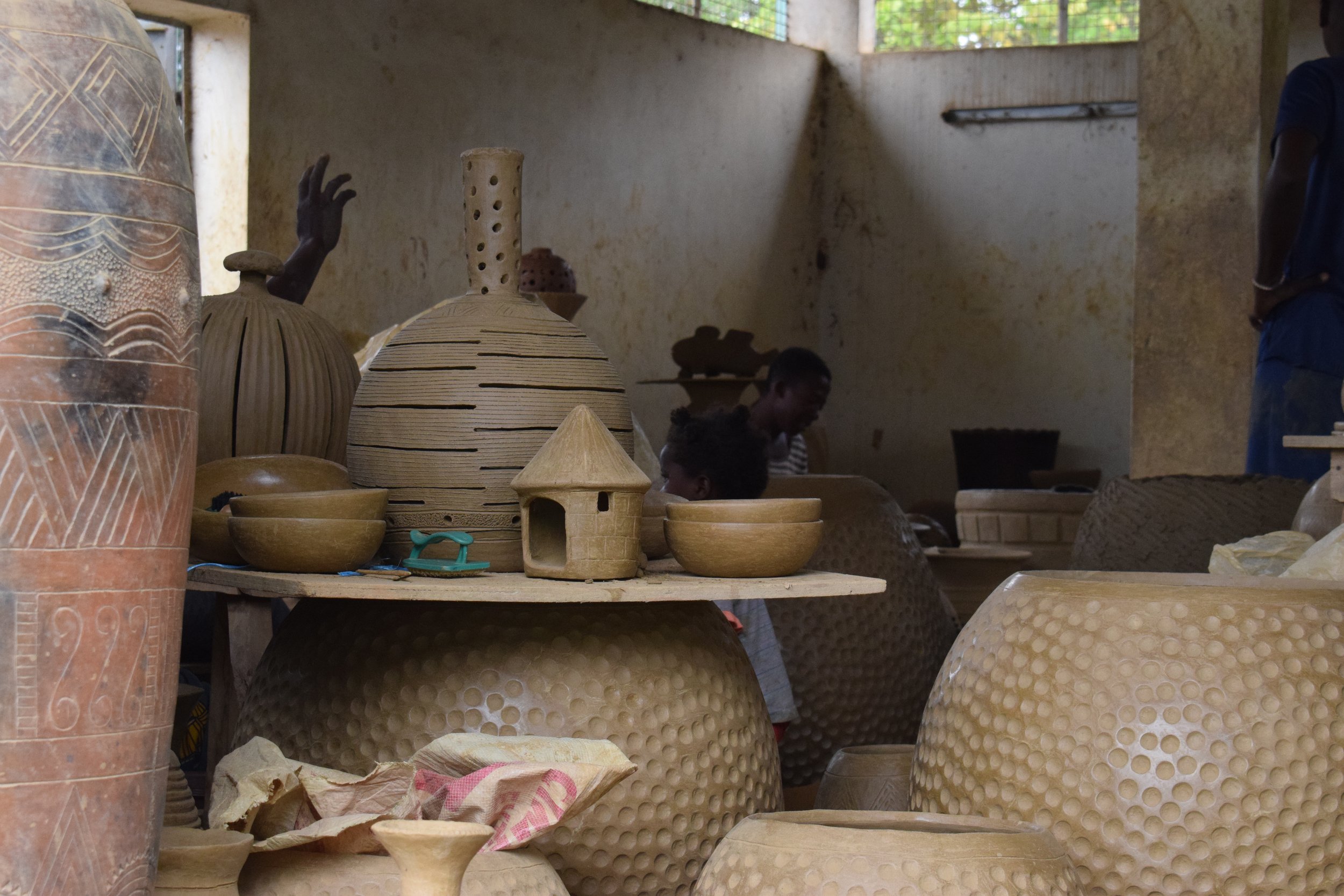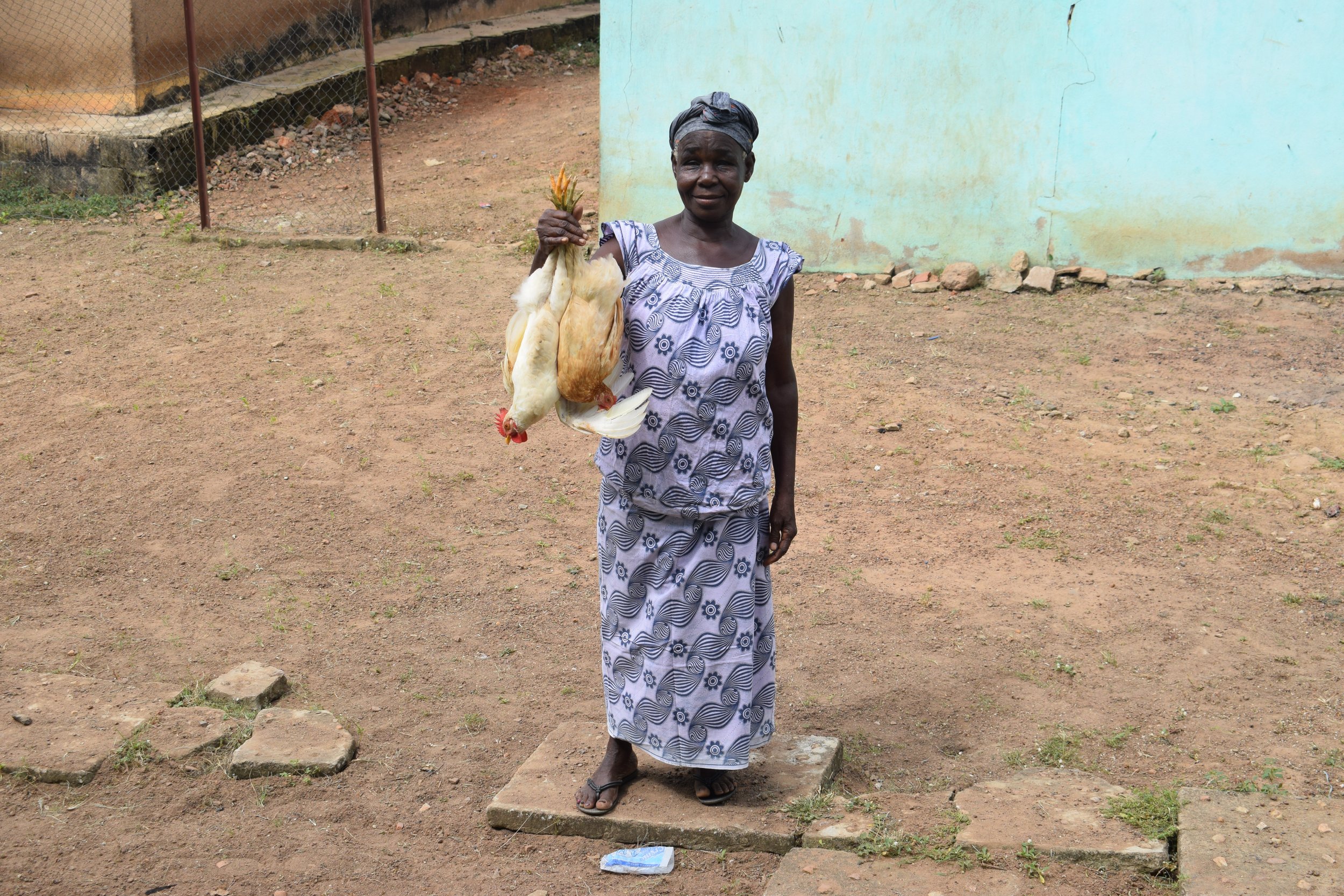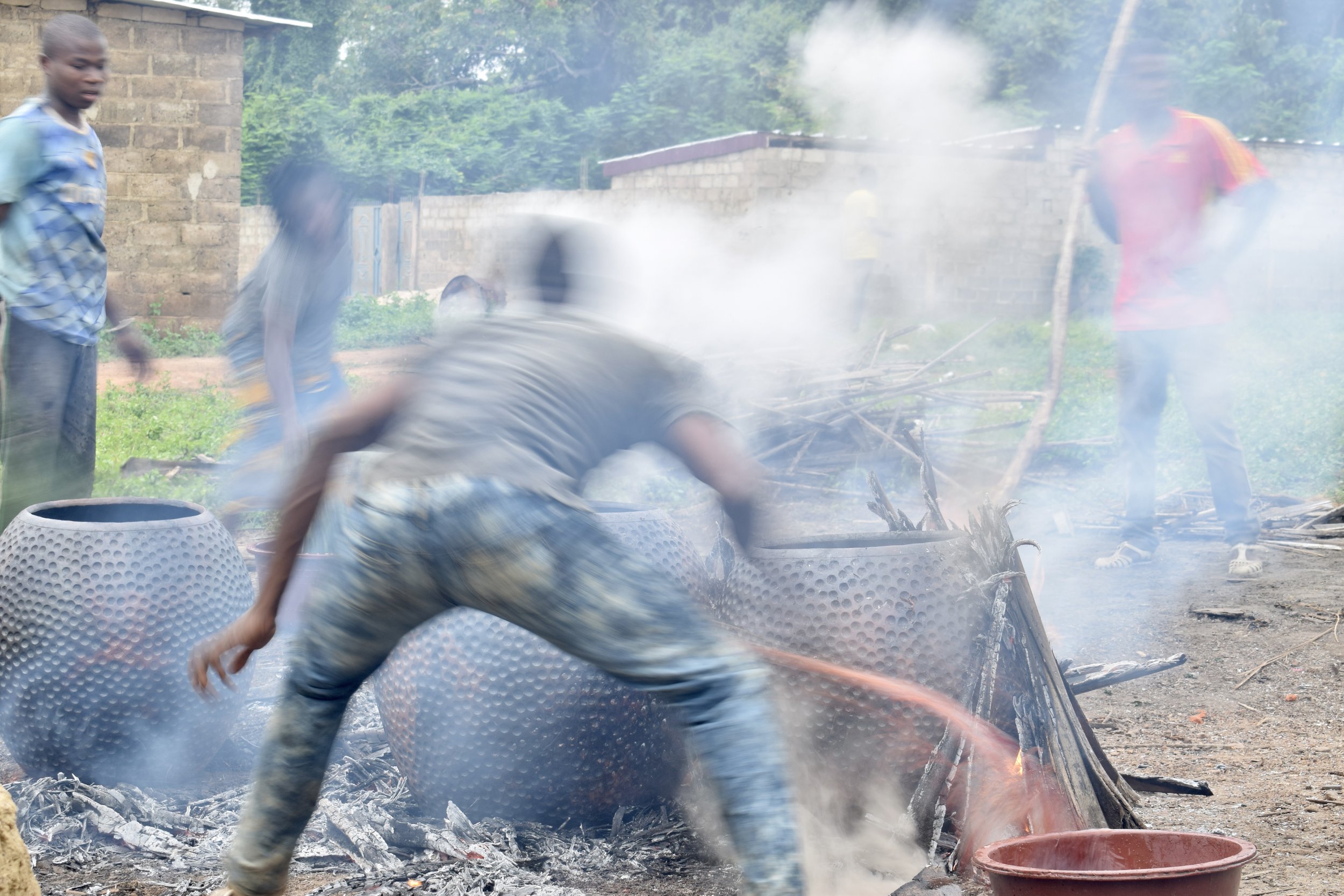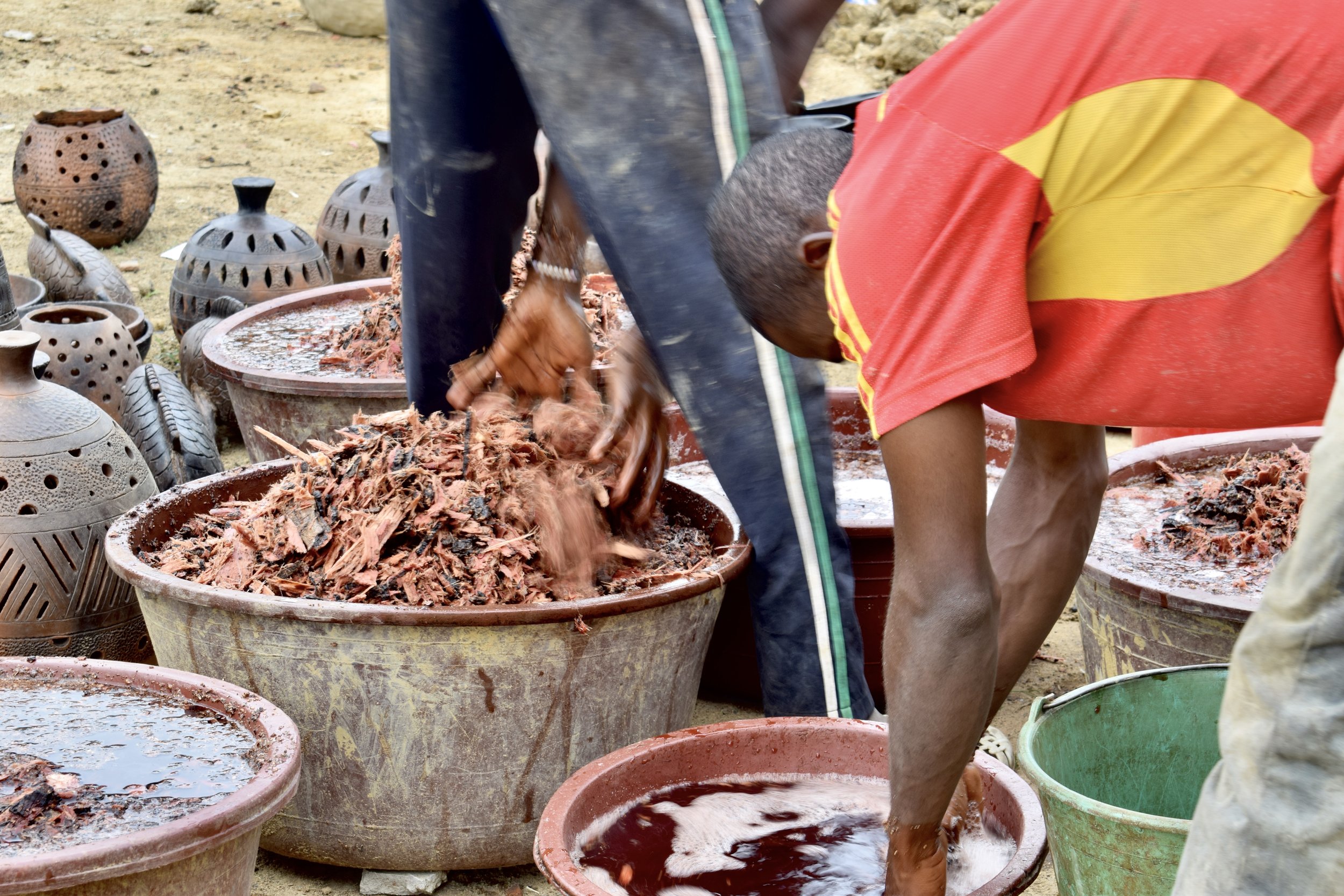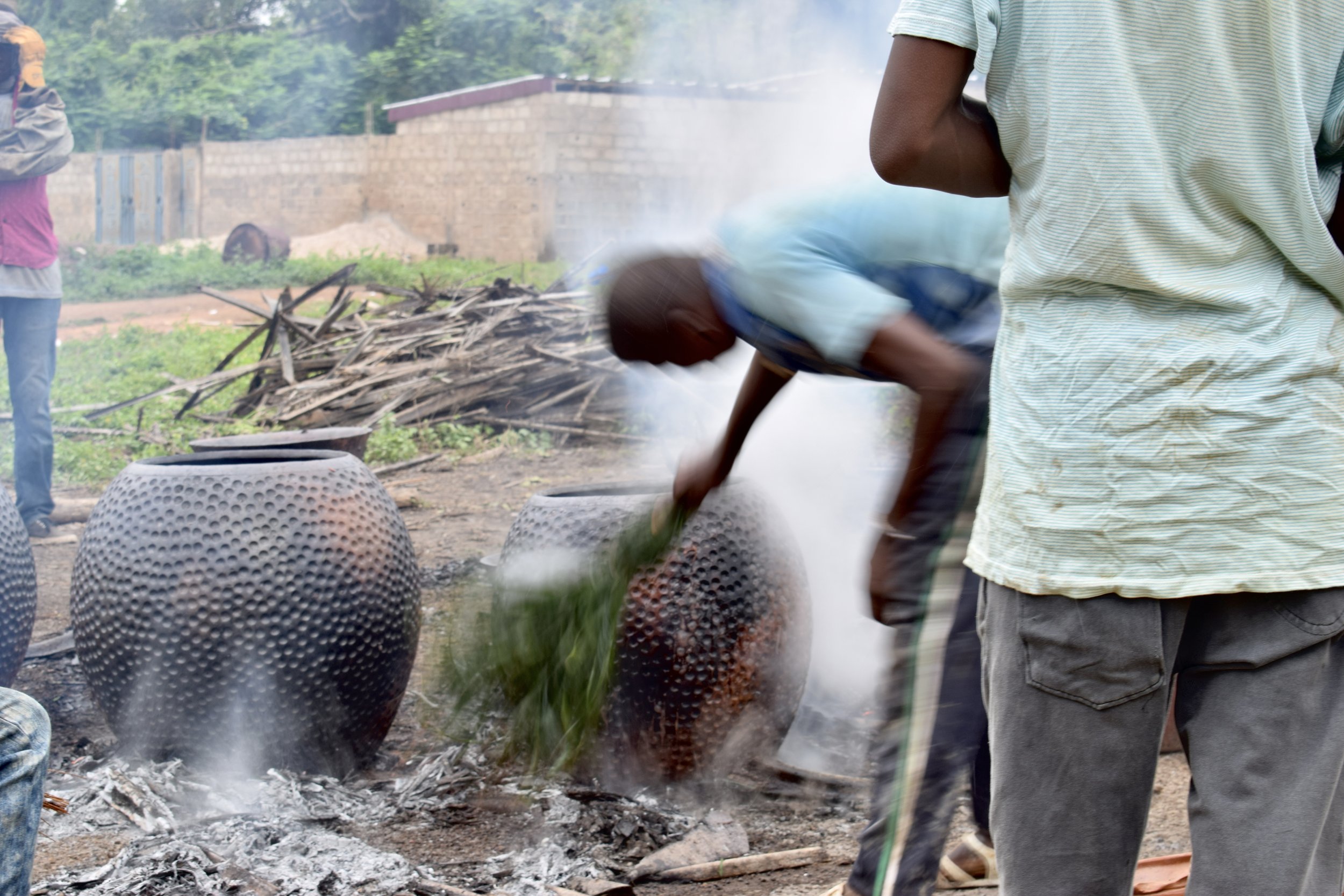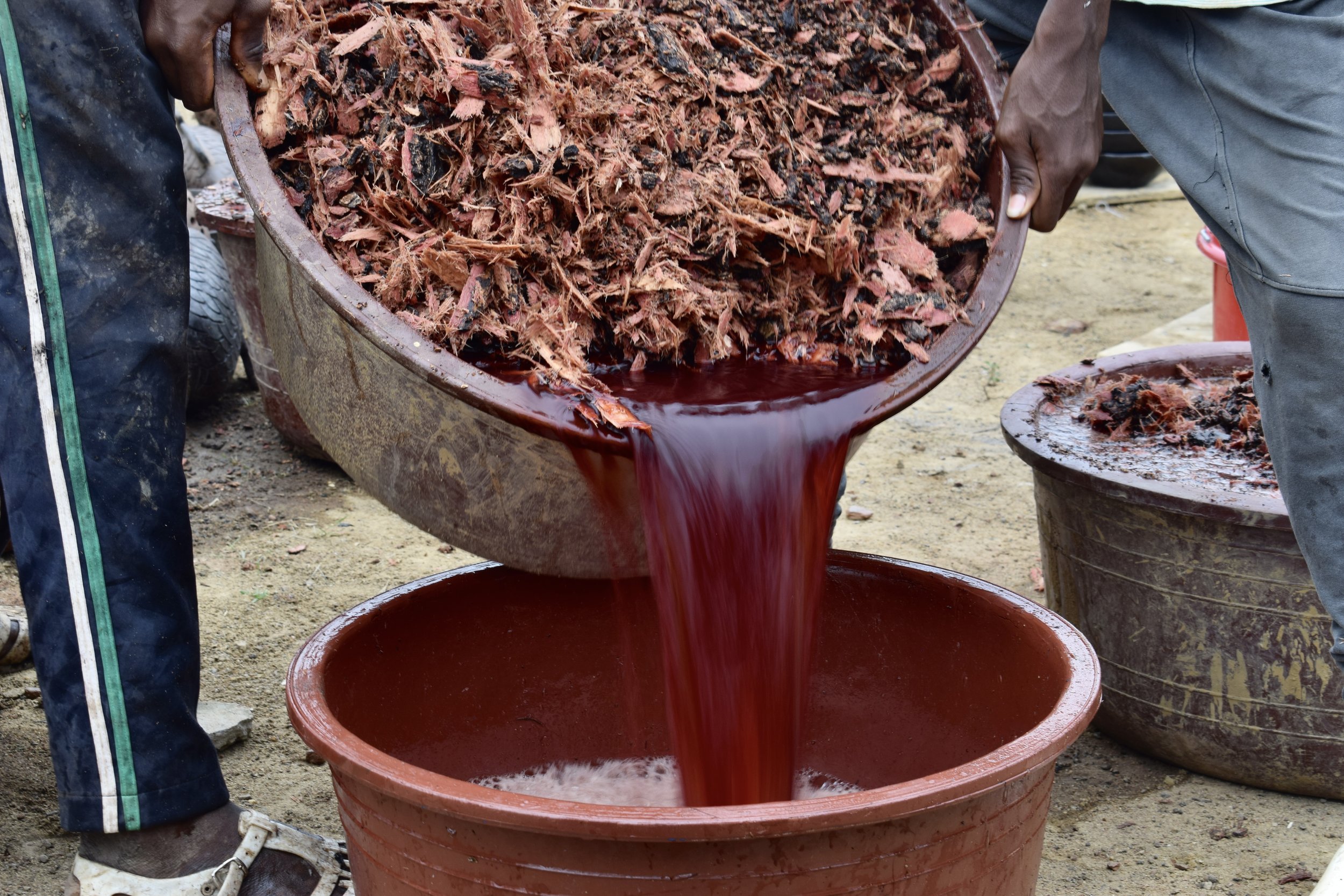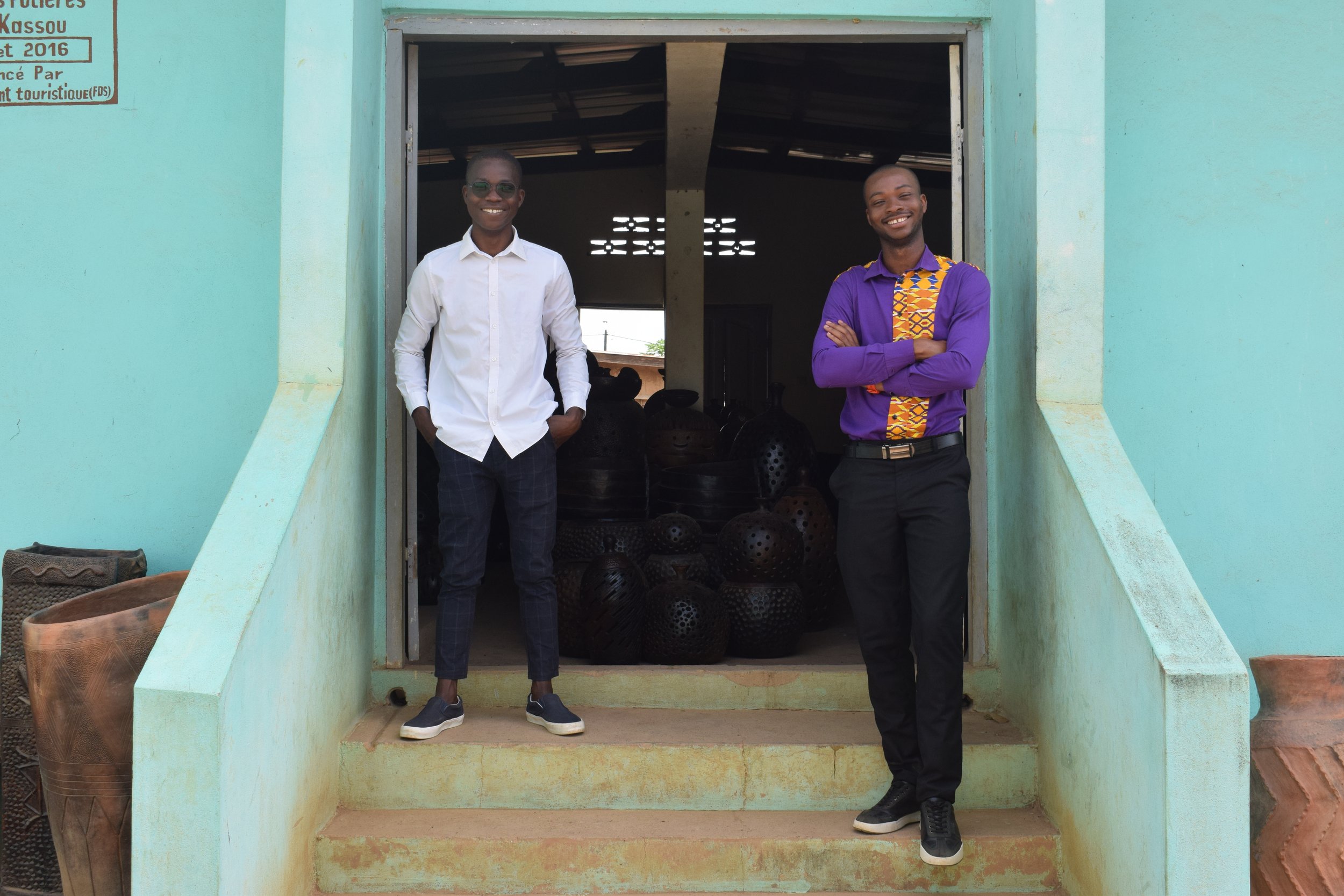“Stop crying.”
“Tell her to stop crying.”
She was speaking in Baulé, the local language spoken by the Baulé people, which was being interpreted into French by Aya Akissi Hélène — the president of the Cooperative of Potters in Tanou Sakassou —, which was being interpreted into English by Ray, my interpreter. I had travelled 8,296 kilometres (5,155 miles) and even though we were sitting right next to each other, there was a long language distance still to be travelled.
I just couldn’t stop crying. The mélange of emotions I was feeling was too overwhelming. I had met her when I thought she was dead. I was having a conversation with her that I had had so many times in my head. Words I had thought I would never be able to share with her directly.
I was in front of Kouame Kakahá. The woman I had been searching for for three years.
In 2020, I made one vessel copying the shape and the curves of her signature pot — the only pot she is still making today. A vessel that was followed by 25 other, the Reunion pieces, through which I talked about her and all the other unnamed women of clay; a project that has been instrumental in my development and growth as a maker.
And now, the reunion was taking place.
In the flesh.
Sharing space at the pottery atelier in her village in Ivory Coast.
So yeah, I was well overwhelmed.
I had been in Côte d’Ivoire for three days. I landed in Abidjan on a Monday and my first encounter with its pottery tradition was in Grand Bassam outside of Abidjan a day after my arrival. I visited the Ceramics Centre there, which was opened by four French people in 1982. Shimpo wheels, a mix of kilns (“modern” and “traditional”), plaster moulds, the machinery necessary to process the clay and lots of pots. A space between the local traditional pottery and a more “modern” approach to making.
A good way to start diving into the purpose of this trip. One that rapidly changed when I got to Tanou Sakassou.
A village of about 800 people in the middle of the country, about a 20-minute drive from Bouaké where I was staying. My interpreter and a driver would pick me every morning to take me to Tanou to hang out with the potters and try to find information about Kouame Kakahá. It was only once the first day was over that I realised how nervous I was before. I didn’t know what I would find, how people would respond to my presence; still very much a white Westerner for them — Blofloué (white person) as the kids in the village would call me.
I was welcomed with open arms and the warmth that I learnt, and experienced, is characteristic of Ivorians. Anicet, one of the oldest men making today and the grandson of the founder of the Cooperative, Koua Aya, introduced me to their work and the atelier’s history. A fascinating journey that was started by Koua Aya in 1986 when she founded the Cooperative as suggested by the Ivorian government and members of the French Cooperation. A Cooperative with only women members first (j’adore much?). A practice that has changed considerably since men arrived at the atelier in the 1990s. Their having been to school brought a new approach to their pieces, new tools and a new mentality. Cooking pots and homewares would be left aside to prioritise the larger decorative sculptural vessels that are more appealing to Western buyers. The dismissal of women’s traditional labour. In with the new with the men. Yet again.
As we chatted, I mentioned I was there to find information about a woman called Kouame Kakahá.
“Ah, she is around - she should come later”, Anicet said.
“But… isn’t she dead?!” My jaw dropped, my heart quickened. I was in total shock.
“No, the person who told you she had passed might have referred to my grandmother, the founder”, he replied.
A plot twist if there ever was one.
We continued the visit of the day, had a delicious meal and visited the clay mine. I was there. I was listening to all the information that was being shared with me. But I was also somewhere else, excited and nervous about the moment I would meet her.
As we were heading back to the atelier, a woman was walking a couple of meters ahead of us. “That’s Kakahá”, Anicet told us and started taking to her in Baulé. The woman turned around, looked at us, laughed and continued walking. As I learnt afterwards, she could not believe I was there to meet her. That I knew her name. She was too dirty for pictures, she said.
We shook hands and I told her “Mama, I am here to meet you” in my broken French. “I have so many things to tell you”. I could not believe my eyes. I already wanted to cry.
Kouame Kakahá and Anicet
The following day she looked for us as we were having lunch with Anicet and Akissi and then came back to the atelier with us. She was waiting for me to talk to her, Ray told me. So there we sat, the four of us, conveying words from one language to the other until we could understand each other. I had prepared a presentation to show her my work, to explain it all and first and foremost, to apologise.
“I am so sorry I used your work without realising it was yours, without giving you credit in the first place”, I said to her in a language she was not understanding as it was coming out of my mouth, tears rushing out of my eyes.
“Don’t cry. Stop crying. There is nothing to worry about.” Forgiveness.
I continued showing her the Reunion pieces to tell her that I had developed a project about her while I was trying to figure out who she was. That I had been told she had passed away. That thanks to her work I had created my own artistic language. That thanks to her being I was.
I had no clue what she thought of me. If I was overwhelmed, how must she have felt? A strange woman coming to her to say sorry and meet her. At first, I thought she hated me. It was all too much.
But every morning she would come to the atelier. First thing. To say magnio (good morning for women). Bonjour mama, I would reply. And she would check out my work. I made my first three canaris (cooking pots) with Akissi. She made the first one to show me the process. We made the second one together; for each step of the process she would start and I would continue. Finally, with the third one, it was my time to show what I had learnt, while she inspected it and answered my questions. I was in heaven.
The decoration was up to me, I could use any of their designs. Instead, I did my thing, which started attracting potters to my station. “Très joli” they would say, relief coming out of every single cell of my body. I wanted to impress them so badly.
One morning, Kakahá came and as I was working on my fourth pot, she started to hold my canaris. “That is heavy!” she said laughing. “Well, I got the approval from Akissi…!” I defended myself, laughing too — it was heavy! Perhaps to compensate, perhaps because she actually meant it, she gave me a très joli as she held the third pot I had made. “Oh, je ne l’aime pas” I said as I was not too convinced with the decoration. She thought it was beautiful so I said “well, that one is for you then”.
As days went by, the same ritual would be followed. She would come in the morning. Magnio to me, manouo to the men. She would sit on one of the plastic chairs that were brought for me and Ray, the interpreter. Plastic chairs I refused to use, as I wanted to sit on the wooden stools to make, just like all the other potters. I wanted to be one of them as we worked next to each other every day.
She would chat away, crack jokes and tease people. This much I gathered from the laughter that would fill the room as she spoke. One day during a little walk around Tanou we passed by her house and she invited us — Willy, another interpreter, and myself — to sit with her outside. We were rather lost in translation, as Willy could not speak much Baulé and she would speak very little French. Still, we hung out there, talking about her life, her siblings, her children. She didn’t know when she had started doing pottery but she didn’t have children then. Pottery was a gift of God for her. When one has a talent, it is a gift of God, she told us. And she honoured it.
Back in the days she used to make many other pieces like the other women: N’zué sè (water containers), Talié (soup bowls), Cloué (the chef’s pot for palm wine). One day, inspired by the testicles of the goats that also populate Tanou and that spend their days searching for shade as the sun shines mercilessly, she made her two-legged vessel and another one with three legs. Jerry Vogel, an American man that used to visit Tanou Sakassou regularly and whom the potters adore, particularly loved the two-legged one and encouraged her to focus on that one. These days, as her energy levels decrease and the noise levels at the atelier increase with more and more young men joining, she only makes the two-legged vessels in the comfort of her home.
So it turned out she was coming to the atelier every day because I was there. I guess la vieille, as older women are called in Tanou, was growing fond of me and wanted to see what I was up to. Like the rest of the potters, little by little, they were getting used to my presence and appreciating the fact that I was there working with them, learning from them and showing respect towards their labour.
This was confirmed on one of my last days when Kakahá popped by holding two chickens. The women of the cooperative wanted to cook them in my honour. I was chuffed and humbled. So I offered to kill them as it is customary in Baney (Equatorial Guinea) when a chicken is being offered to a special guest. They thought I was mad so instead, I just offered to cook with the women. Sharing space with them in their kitchens as they pounded banana and cassava to make foutou definitely was one of my favourite parts of my stay in Tanou. That day, they let me pound as well. “She has African blood” one of the interpreters said, while Kakahá rested her face in her hands, probably horrified by my pounding technique. We both just laughed.
On my last day, after having spent three hours polishing my big pot (one I had made to prove the men I could. “Women don’t make big pots, they require a lot of strength” they would repeat to me, encouraging me more and more to give it a go - which I, bien sûr, did), I went to Kakahá’s house to give her her pot, the one she thought was pretty, which actually was after the two firings.
I went alone. “Mama, un petit cadeau pour toi”, a small present for you I said. She understood and smiled as she held it with admiring eyes. She did indeed like it. We chatted for a while, exchanged contacts and off I went beyond happy.
Canari I , this one is for me
Canari II, for Akissi
Canari III, for Kakahá
That day at lunch both her and Akissi joined us to say their official goodbyes. They considered me part of their family and were grateful for my having come to Tanou. I felt — and still feel — extremely lucky and thankful for their generosity and kindness.
An image online had taken me to Kakahá. A piece of ceramics that gave me the space, the canvas, the reason and the opportunity to push my own creative practice. A piece of ceramics that introduced me to all the potters of Tanou Sakassou; to a family, to a heritage.
I have so much to thank Kouame Kakahá for, which I hope she understood. And while I was there, I continued receiving so much from this community of potters. So I worked hard every day to show them my respect. I shared with them my own way of working which they seemed to love and now my duty to them continues. They gave me permission to write about their Cooperative and its history to help them give visibility to this remote and incredible place full of talent, beautiful humans and, of course, clay.
So here I am. Back from a proper life-changing trip.
Here are my first words about it all.
And here I leave you some images from Tanou Sakassou. From the time when I found Kouame Kakahá.
Clay at the mine
Kiln built by the Tanou potters where the first firing takes place
Kouame Kakahá preparing her second firing
Charles, Kouassi, Bernadette and Alexandre doing the second firing. The pieces are taking out of the fire while still hot to apply an infusion made out of the bark of a local tree called Bridelia Ferruginea or Séa in Baulé
Alexandre and Kouassi preparing the Séa infusion
Kouassi and the fire
Séa infusion to decorate the pieces
Some of the Tanou Sakassou potters with my pot — decorated in collaboration with Charles. The woman in the middle with the headscarf is Akissi, President of the Cooperative
Tanou Sakassou
Tanou Sakassou
Tanou Sakassou
Akissi, Yanis, Alexandre, Charles, Anicet, Bernadette and one of the youngsters
Ray and Willy, interpreters
Finished pots after the second and final firing, still resting where the fire took place

